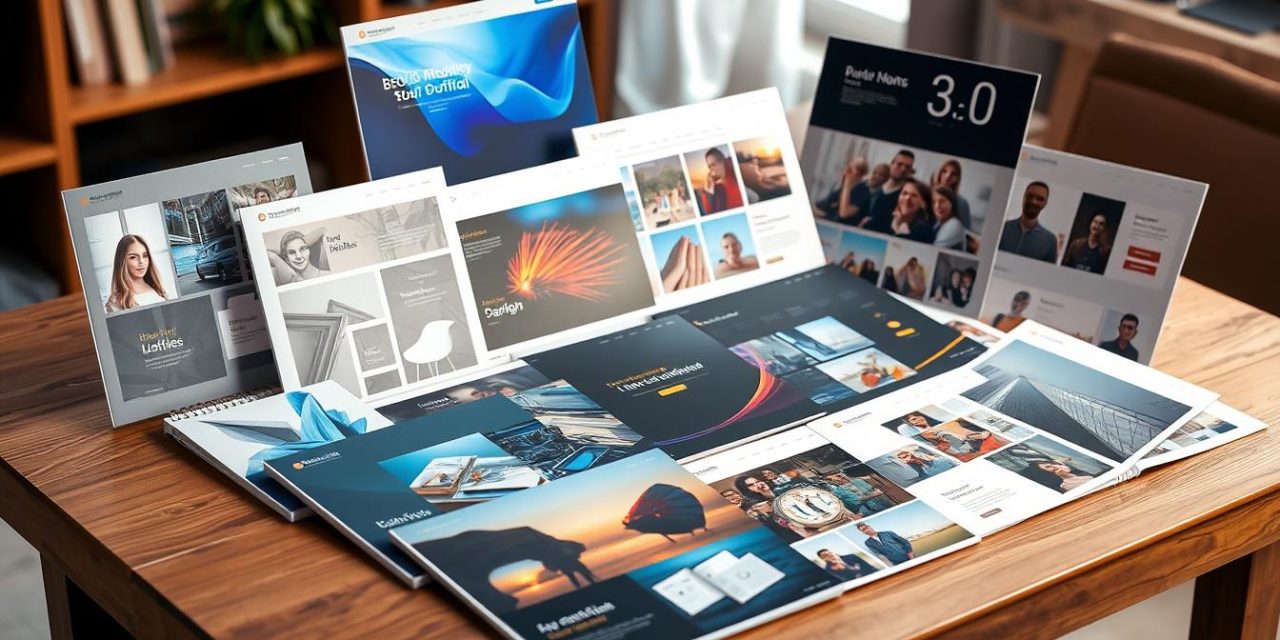Remember that moment when you sat across from a potential client, hands slightly trembling as you shared your work? That’s where your journey begins. In a world where trust is earned through proof, not promises, your portfolio becomes your silent partner—the bridge between doubt and confidence.
Your collection of work isn’t just files in a folder. It’s a strategic asset that answers the unspoken question every client asks: “Can you solve my problem?” Unlike traditional resumes, it shows—not tells—your ability to deliver real results. Today’s clients prioritize what you’ve achieved over where you studied.
This guide will help you transform scattered projects into a cohesive narrative. Whether you’re a designer, writer, or consultant, your curated work samples act as freelance portfolio essentials that demonstrate your unique value. We’ll explore how top professionals use their portfolios to triple inquiries while commanding premium rates.
Table of Contents
Key Takeaways
- Your portfolio replaces traditional credentials with visible proof of expertise
- Strategic curation increases client trust and project opportunities
- Combining storytelling with results drives higher conversion rates
- Digital portfolios serve as 24/7 business development tools
- Regular updates maintain relevance in evolving markets
By the end of this guide, you’ll understand how to position your best work as undeniable evidence of your professional capabilities. Let’s create something that doesn’t just display your skills—it amplifies them.
Understanding the Importance of a Freelance Portfolio
What separates professionals who consistently attract premium projects from those stuck chasing opportunities? The answer lies in strategic communication through your work presentation. When potential collaborators review your collection, they’re not just browsing—they’re seeking confirmation you can deliver measurable outcomes.
Establishing Your Value Proposition
Your curated projects act as silent negotiators. A marketing consultant might showcase a campaign that tripled website traffic in three months. A UX designer could highlight an interface redesign that reduced customer support calls by 40%. These concrete examples answer the critical question: « What transformation can you create for me? »
Select pieces demonstrating diverse challenges and solutions prove adaptability. Include brief context about client objectives and how your approach addressed them. This structure positions you as a problem-solver rather than just a service provider.
Differentiating Yourself from the Competition
Specialized knowledge becomes your leverage. If you’ve mastered compliance-driven industries like healthcare or finance, emphasize this expertise. For creative fields, display signature techniques that set your work apart—maybe a distinctive illustration style or data visualization method.
Incorporate client feedback strategically. A testimonial stating « Their attention to regulatory details saved us six weeks in legal review » carries more weight than generic praise. These social proofs address hiring anxieties by demonstrating real-world reliability.
Identifying Your Niche and Target Client Base

Imagine standing at a crossroads where every client decision shapes your career path. Specialization isn’t about limiting opportunities—it’s about strategic focus that attracts higher-value projects. The key lies in understanding who needs your expertise most and why.
Creating Your Buyer Persona
Start by sketching your ideal collaborator. Are they a tech startup founder needing rapid prototyping? A healthcare administrator seeking compliance-focused solutions? Document their professional challenges, decision-making criteria, and preferred communication styles. For instance:
| Generalist Approach | Specialized Focus |
|---|---|
| « Web design for small businesses » | « E-commerce UX optimization for luxury brands » |
| Average project fee: $1,500 | Average project fee: $8,000+ |
| Conversion rate: 12% | Conversion rate: 34% |
This clarity lets you craft case studies that speak directly to their priorities. Analyze past successful collaborations—what patterns emerge in client industries or project types?
Analyzing Client Needs and Trends
Monitor emerging demands in your field through tools like Google Trends and industry reports. A cybersecurity consultant might notice increased demand for AI threat detection systems. A copywriter could identify growing requests for sustainability-focused messaging.
Combine this data with proven client retention strategies to validate your niche. Test your specialization through small-scale projects before full commitment. Remember—the goal is becoming the obvious choice for specific challenges, not just another option.
Choosing the Right Content for Your Freelance Portfolio
The difference between a forgettable collection and a client-winning portfolio lies in strategic selection. Your work samples become a visual handshake—a chance to demonstrate expertise while addressing specific client priorities.
Showcasing Work Samples and Case Studies
Focus on projects mirroring your ideal assignments. A graphic designer might highlight packaging that increased shelf conversions by 18%. Developers could display code snippets solving complex scalability issues.
Structure case studies using this framework:
- Client challenge: « Needed multilingual support within tight deadlines »
- Your solution: « Implemented AI-driven localization tools »
- Measured impact: « Reduced translation costs by 37% »
This approach transforms finished products into decision-making tools for prospects. Include before/after comparisons when possible—they make improvements tangible.
Leveraging Client Testimonials and Recommendations
Authentic feedback acts as trust accelerators. Feature quotes addressing common concerns:
« They navigated complex compliance requirements while maintaining our brand voice—exactly what we needed. »
Pair testimonials with relevant projects. A testimonial about meeting deadlines belongs beside a time-sensitive delivery case study. This synergy turns praise into proof of capability.
Update your collection quarterly. Remove outdated pieces that no longer reflect your best work or target market needs. Quality curation builds authority faster than quantity ever could.
Designing a Visually Compelling and Functional Portfolio
What transforms a digital showcase from ordinary to unforgettable? Strategic design choices that balance beauty with purpose. Your site must work as hard as you do—guiding visitors toward collaboration while reflecting your professional identity.
Implementing Clean, Ergonomic Design Principles
Prioritize clarity over complexity. Use ample white space and intuitive menus that let your work take center stage. Fast-loading pages and mobile optimization aren’t optional—47% of users abandon sites that take over 2 seconds to load.
Choose expert website design solutions that adapt to any screen size. Tools like Squarespace offer professional templates requiring minimal technical skills. Remember: simplicity demonstrates confidence in your abilities.
Integrating Personal Branding Elements
Your color palette and typography should mirror your professional persona. A cybersecurity specialist might use bold, secure-feeling blues, while a children’s illustrator opts for playful rounded fonts. Consistent visual language across business cards, proposals, and your site builds recognition.
Place your logo strategically—the top-left corner captures attention first. Pair this with a concise value statement using your brand voice. Every element should whisper, “This is who I am and how I deliver results.”
Implementing a Strategic Process and Call-to-Action

Clear processes turn uncertainty into confidence—both for you and those evaluating your services. By mapping your methodology, you transform abstract skills into tangible value. This transparency addresses a core client concern: “How will you deliver results?”
Mapping Out Your Workflow Steps
Break projects into distinct phases that showcase your precision. Start with discovery calls to align expectations. Move into planning sessions where clients review prototypes or drafts. Include quality assurance checkpoints to highlight your attention to detail.
Label each stage with action-oriented terms like “Strategy Blueprint” or “Precision Refinement.” This transforms generic steps into branded differentiators. For web projects, show how you optimize site performance at every phase—from initial wireframes to final launch.
Crafting Engaging Calls-to-Action
Guide visitors toward collaboration with purpose-built prompts. Place contact buttons at natural decision points—after case studies or team bios. Test different formats:
- Interactive quote calculators for budget-conscious clients
- Calendar widgets showing real-time availability
- Project-specific inquiry forms
One architectural designer increased inquiries by 29% by adding a “Visualize Your Space” button linking to 3D mockup examples. Remove barriers by keeping forms short and mobile-friendly.
End your site with a dual-path invitation: “Schedule a free consultation or send project details for instant review.” This accommodates both planners and those ready to act immediately.
SEO Best Practices for Your Freelance Portfolio
Have you ever wondered why some professionals appear first when clients search for solutions? Strategic SEO transforms your digital presence into a 24/7 client magnet, connecting your expertise with those actively seeking your skills. By optimizing your content effectively, you ensure your work gets seen by decision-makers at the perfect moment.
Smart Keyword Implementation
Start by researching terms your ideal clients use. Tools like Google Keyword Planner reveal phrases like « e-commerce UX audit » or « multilingual content localization. » Integrate these naturally into project descriptions and service pages—never force them. A balanced approach maintains readability while signaling relevance to search engines.
Long-tail keywords often deliver higher-quality leads. Instead of competing for « graphic designer, » target specific queries like « brand identity designer for sustainable startups. » This precision attracts clients ready to collaborate.
Optimize meta titles and descriptions to spark curiosity. Keep them under 160 characters with clear value propositions. For example: « Web Accessibility Specialist | WCAG Compliance Audits + Implementation. » Pair this with mobile-friendly design principles to boost search rankings and user experience simultaneously.
Update content quarterly to reflect industry trends. Add fresh case studies addressing emerging needs like AI integration or GDPR compliance. This consistent refinement keeps your visibility high and relevance undeniable.
FAQ
How often should I refresh my professional showcase?
Update quarterly or after completing major projects. Highlight recent achievements, skills, and client feedback to demonstrate evolving expertise. Regular updates improve search visibility and client trust.
What if I lack client testimonials for my services?
Start with detailed case studies of personal projects or pro bono work. Use metrics like efficiency gains or problem-solving examples. LinkedIn endorsements and skill assessments also build credibility.
How do I select the best platform for my work collection?
Match platforms to your industry—WordPress for designers, GitHub for developers. Prioritize customization, mobile responsiveness, and SEO tools. Platforms like Squarespace offer built-in analytics for performance tracking.
Can strong visuals compensate for limited content in my showcase?
Balance is key. Use high-quality images with concise project summaries. Pair visuals with context like client goals, your process, and measurable outcomes to demonstrate problem-solving abilities.
Why does mobile optimization matter for my professional site?
58% of hiring managers view portfolios on mobile devices. Use responsive templates, compress images, and test load speeds. Tools like Google Mobile-Friendly Test identify improvement areas.
How do I optimize for search engines without sounding robotic?
Naturally integrate terms like « UX design services » or « full-stack development » into project descriptions. Use headers strategically and add alt text to images. Tools like SEMrush help maintain 1-2% keyword density.
Should I include confidential projects in my work samples?
Create sanitized versions that highlight your role without revealing sensitive data. Use generic titles like « Enterprise SaaS Platform Redesign » and focus on your problem-solving framework.
What makes an effective call-to-action for potential clients?
Use action-oriented language like « Schedule a free consultation » or « Download my service catalog. » Place CTAs after case studies and pair them with contact forms for immediate engagement.
How can I track visitor engagement on my professional site?
Implement Google Analytics to monitor page views, bounce rates, and conversion paths. Heatmap tools like Hotjar reveal how visitors interact with your content and navigation elements.
What’s the best way to transition between industries in my showcase?
Create separate service pages with tailored case studies. Highlight transferable skills—like data analysis for marketing-to-finance transitions. Use client personas to address each industry’s specific pain points.





